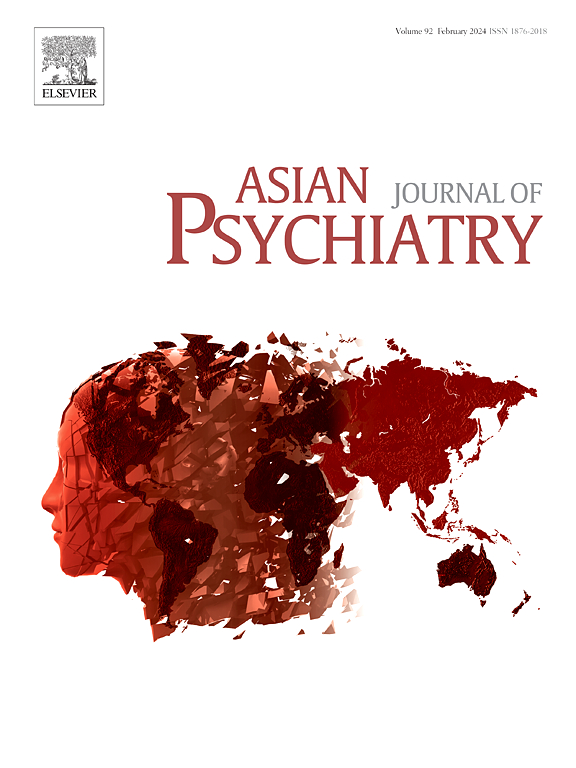Impaired facial emotion recognition in individuals with bipolar disorder
IF 3.8
4区 医学
Q1 PSYCHIATRY
引用次数: 0
Abstract
Background
Individuals with bipolar disorder (BD) often struggle with emotional regulation and social interactions, partly due to difficulties in accurately recognizing facial emotions.
Methods
From September 2021 to February 2023, 69 BD individuals-comprising 23 with bipolar manic/hypomanic episode (BME), 23 with bipolar depressive episode (BDE), 23 with bipolar euthymic (EUT)-and 23 healthy controls (HCs) were enrolled. Diagnosis adhered to DSM-IV criteria using M.I.N.I 5.0, alongside assessments via Hamilton Depression Scale 17 and Young Manic Rating Scale. Recognition tasks involving 84 facial expression images across six categories. The Wilcoxon rank-sum test compares two groups, while the Kruskal-Wallis test compares multiple groups with subsequent adjusted pairwise comparisons.
Results
The overall correct recognition rate of facial expressions in the BD group (79 %) was significantly lower than that of the HC group (83 %) (P=0.004). Primary differences were noted in neutral (93 % vs. 100 %, P=0.012) and fear (79 % vs. 86 %, P=0.023) expressions. Within the BD group, correct recognition rates were 71 % for BME, 80 % for BDE, and 80 % for EUT, all lower than in the HC group. Significant differences in correct recognition rates of neutral, fear, and joy expressions were observed among the four groups (P<0.05), with the BME group exhibiting the lowest rate. Misidentification of facial expressions was more frequent in the BD group compared to the HC group, particularly among negative expressions.
Conclusion
Patients with BD demonstrate lower correct recognition and higher misidentification rates of facial expressions, with those experiencing manic episodes showing impaired recognition of neutral, joy, and fear expressions.
双相情感障碍患者的面部情绪识别能力受损
方法从 2021 年 9 月到 2023 年 2 月,研究人员招募了 69 名双相情感障碍患者,其中包括 23 名双相躁狂/躁狂发作患者(BME)、23 名双相抑郁发作患者(BDE)、23 名双相优郁患者(EUT)和 23 名健康对照组(HC)。诊断遵循 DSM-IV 标准,使用 M.I.N.I 5.0,并通过汉密尔顿抑郁量表 17 和青年躁狂评定量表进行评估。识别任务涉及六个类别的 84 张面部表情图片。Wilcoxon 秩和检验对两组进行比较,而 Kruskal-Wallis 检验则对多组进行比较,并随后进行调整后的配对比较。结果BD 组面部表情的总体正确识别率(79%)明显低于 HC 组(83%)(P=0.004)。主要差异表现在中性(93% 对 100%,P=0.012)和恐惧(79% 对 86%,P=0.023)表情上。在 BD 组中,BME、BDE 和 EUT 的正确识别率分别为 71%、80% 和 80%,均低于 HC 组。中性、恐惧和喜悦表情的正确识别率在四个组之间存在显著差异(P<0.05),其中 BME 组的识别率最低。结论BD 患者的面部表情识别正确率较低,识别错误率较高,其中躁狂发作的患者对中性、喜悦和恐惧表情的识别能力受损。
本文章由计算机程序翻译,如有差异,请以英文原文为准。
求助全文
约1分钟内获得全文
求助全文
来源期刊

Asian journal of psychiatry
Medicine-Psychiatry and Mental Health
CiteScore
12.70
自引率
5.30%
发文量
297
审稿时长
35 days
期刊介绍:
The Asian Journal of Psychiatry serves as a comprehensive resource for psychiatrists, mental health clinicians, neurologists, physicians, mental health students, and policymakers. Its goal is to facilitate the exchange of research findings and clinical practices between Asia and the global community. The journal focuses on psychiatric research relevant to Asia, covering preclinical, clinical, service system, and policy development topics. It also highlights the socio-cultural diversity of the region in relation to mental health.
 求助内容:
求助内容: 应助结果提醒方式:
应助结果提醒方式:


